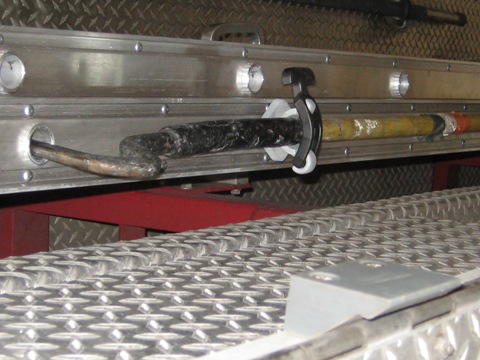
Emergency Vehicle Driver Dean Denning from Baltimore City Truck Company #5 sent in this slick method of storing & carrying the OVM tools. He graciously gave credit to Baltimore City Truck Company #29 for the original idea. Check out the Tips from the Bucket page for details.

Need some clarification on this part.
the long bolts were placed through the rungs of the fly section, thus maintaining the ladder’s integrity by not drilling into the bed section.
The above Question was not from VentEnterSearch.com Jeff…
Sorry about not writing it more clear the first time. That post was written in the wee hours of the morning.
They used a long piece of threaded rod, and basically made a super long bolt out of it. This bolt goes through the existing hole in the rung, from one side to the other. A large washer and nut secure the assembly on the other side. This method eliminates having to drill into the beam of the ladder. We’ll try to post a picture for the other side to clear up any confusion. -Jimm-
Interesting idea! At first glance I like it, but the question that begs to be asked is, “How do you do a beam raise with the tool or brackets strapped to the beam?”
If you’ve been lucky enough to see Mike Ciampo’s street smart ground ladders program you’ll recall his “new” (read: non-IFSTA) method is to set the beam on your outside shoulder (body to the building so there’s never a blind spot created by the ladder as you’re conducting continuous size up during the raise) and just walk toward the butts, with your shoulder raising the weight ladder not being offset by an equally-involved butt-man.
Again, I like the idea, but it seems it may increase effeciency on one hand, while decreasing it on the other. Of course, if you ALWAYS carry the ladder with the tool facing up and fly to your body, it’s no problem…
Be safe Brothers.
Chris
Please forgive me, I’m on an Engine, but I was left quessing what “OVM” tools stood for. I have not heard of an acronym for ventilation tools as of yet.
A piece of velcro works great too. (the same strap used to marry a set of irons) this way A & B shift cant bitch about it either.
Jason : OVM = Outside Vent Man. Its a position on the truck, not a tool.
Will it work with any hook, or just the boston rake? Comming from a southern dept. the boston rake doesn’t even exist. But National standard pike poles and NY Roof hooks are the norm. Just wonderign if anyone has tried it with these tools. Love the idea hopefully we will have something to make it work.
I’m currently one of the Training Captains for Miami-Dade Fire Dept., and we’ve been doing extensive training with ground ladders recently with our companies. Such as single man beam raises and having your roof hook attached/sitting atop of the top beam with the hook inserted in the hole of the rungs. This idea is awesome!,keeps your tool secured at all times and you don’t have to look for your hook, because it’s already there. Keep up the good work fellas with your very informative website.
Capn Gonzo
MDFR
Isn’t it amazing what kind of brilliant ideas firemen can come up with! Everything’s clear on how to mount the bracket but I can’t seem to find the hook bracket that is shown in the picture. I found a Zico that is very similar but not exactly it. Any help with where to buy the brackets??? Stay low and stay safe.
Brad
For the record, I just wanted to thank BCFD Trucks 5 and 29 (as well as this site) for the idea and information. It popped directly into my head Friday night at a 2nd alarm fire. As the acting chauffeur for the 2nd-due truck, I got my rig set up and went to throw some ladders. I grabbed a hook and as I took ladders off the 1st-due truck, this topic came to mind.
I used the ‘hook and ladder’ tactic with a couple of slight variations. We don’t have brackets on our ground ladders, but our truck company ladders are of truss construction. The heads of the NY-style hooks we use won’t fit in the bore of a rung, but I found out ‘on the fly’ that they will fit nicely into the web of the truss. This tactic provided an edge in getting some timely laddering and OV work done, both shaving off some time and effort.
With so much of the efficiency and success of any operation we perform resting on the smallest details, I am extremely appreciative and grateful for a means where firefighters from all over the country (and I’m betting other parts of the world) can share their experiences, ideas and tricks.
Thanks again and be safe.